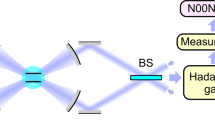Abstract.
We show how to generate bilinear (quadratic) Hamiltonians in cavity quantum electrodynamics (QED) through the interaction of a single driven three-level atom with two (one) cavity modes. With this scheme it is possible to generate one-mode mesoscopic squeezed superpositions, two-mode entanglements, and two-mode squeezed vacuum states (such the original EPR state), without the need for Ramsey zones and external parametric amplification. The degree of squeezing achieved is up to 99% with currently feasible experimental parameters and the errors due to dissipative mechanisms become practically negligible.
Similar content being viewed by others
References
A. Einstein et al., Phys. Rev. 47, 777 (1935)
J.S. Bell, Physics (Long Island City, NY) 1, 195 (1964)
C.J. Villas-Bôas et al., Phys. Rev. A 60, 2759 (1999)
L.M.K. Vandersypen et al., Nature 414, 883 (2001)
J.N. Hollenhorst, Phys. Rev. D 19, 1669 (1979)
D. Stoler, Phys. Rev. Lett. 33, 1397 (1974)
H.J. Kimble et al., Phys. Rev. Lett. 39, 691 (1977)
R.E. Slusher et al., Phys. Rev. Lett. 55, 2409 (1985)
S. Haroche, Nuovo Cim. B 110, 545 (1995); D.M. Meekhof et al., Phys. Rev. Lett. 76, 1796 (1996)
C.J. Villas-Bôas et al., Phys. Rev. A 68, 061801(R) (2003)
R.M. Serra et al., preprint arXiv:quant-ph/0306126
This dipole-forbidden transition can be induced by taking advantage of dipole-allowed transitions to another auxiliary level. In this case, a fourth level | f〉 must be added to the atomic system together with appropriated classical fields inducing a Raman transition with effective coupling given by \(\Omega =g_{1}^{\ast }g_{2}/% \widetilde{\Delta }\), g1 and g2 being the coupling constants to the vicinity of the dipole-allowed transitions | g〉 ↔| f〉 and | e〉 ↔| f〉, both with detuning \(\widetilde{% \Delta }\gg | g_{1}| ,| g_{2}| \). For the strong coupling regime it is required that Ω∼106 s-1, which follows from g1∼g2∼107 s-1 (easily achieved for dippole-allowed transitions). Note that we may also consider the auxiliary level | i〉 itself for this purpose, watching out for the classical fields to be far from resonance with the cavity modes.
E. Solano et al., Phys. Rev. Lett. 90, 027903 (2003); see also S. B. Zheng, Phys. Rev. A 66, 060303 (2002)
D.F.V. James, Fortschr. Phys. 48, 823 (2000)
S.L. Braunstein et al., Phys. Rev. A 64, 022321 (2001)
J.M. Raimond et al., Rev. Mod. Phys. 73, 565 (2001)
A. Furasawa et al., Science 282, 706 (1998)
B.T.H. Varcoe et al., Nature 403, 743 (2000)
B. Yurke, D. Stoler, Phys. Rev. Lett. 57, 13 (1986)
M. Brune et al., Phys. Rev. A 35, 154 (1987)
H.R. Lewis, W.B. Riesenfeld, J. Math. Phys. 10, 1458 (1969)
C.J. Villas-Bôas et al., Phys. Rev. A 68, 053808 (2003)
P. Tombesi, D. Vitali, Phys. Rev. A 50, 4253 (1994)
R. Guzmán et al., preprint arXiv:quant-ph/0407218
Author information
Authors and Affiliations
Corresponding author
Rights and permissions
About this article
Cite this article
Villas-Bôas, C., Moussa, M. One-step generation of high-quality squeezed and EPR states in cavity QED . Eur. Phys. J. D 32, 147–151 (2005). https://doi.org/10.1140/epjd/e2004-00178-y
Received:
Published:
Issue Date:
DOI: https://doi.org/10.1140/epjd/e2004-00178-y




